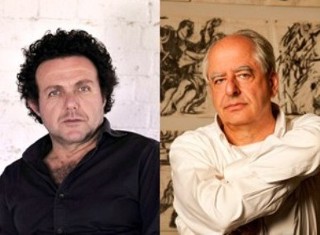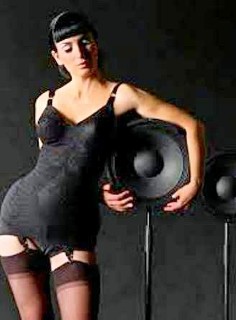|
Back
“Whichever page you open, there you are.” New York
Zankel Hall, Carnegie Hall
10/27/2014 -
“Ubuntu”: Music and Arts of South Africa presents “Paper Music: A Ciné-Concert”:
Part I: Journey to the Moon – Tide Table – Nubian-Landscape (Metronomes) – Plagues – Shards – Medicine Chest – Rebmemer Nuh – Tango for Page-Turning – Other Faces
Part II: Paper Music Suite: Panther (for Rilke) – Looking at a Tree/Waiting for the Sybl – Emergency – Lullaby for House Alarm – iBook (Uses of a Tree) – Sonnet (so long as men can breathe) – Trio for Four Hands
William Kentridge (Drawings, videos, acting), Philip Miller (Music, Gramophone DJ), Joanna Dudley, Ann Masina (Voice), Idith Meshulam (Piano)

P. Miller, W. Kentridge (© Ubuntu)
In less than 90 minutes, William Kentridge and Philip Miller took the full house at Zankel Hall through a panoply of virtual birds, fishes, 17th Century encyclopedias, the plagues of Exodus, metronomes parading as Egyptian pyramids, a beach filled with imaginary cows and Fascist militia, an abstract sonnet, and (in case that wasn’t enough), a demented discourse in Fanagalo, the pidgin language of the Zulu people.
The objects were unreal. They were animated charcoal drawings by Mr. Kentridge, South Africa’s multifaceted philosopher, artist, film-maker, puppeteer, actor, video wizard, and theater and opera director. In fact, his only previous experience in New York, I believe, was directing Alban Berg’s Wozzeck and Shostakovich’s The Nose at the Met, with a production of Lulu next year.
His long-time collaborator for video is fellow South African Philip Miller, whose music was behind the 16 short films shown yesterday. Much of it had been for orchestra or chamber group. For the Carnegie Hall presentation, Mr. Miller had rescored or composed original music for pianist Idith Meshulam, and two extraordinary South African singers: Ann Masina is opera, jazz, gospel and pop singers, and all of this was put to work here. Joanne Dudley is a performance artist, performing everything from voice to ukulele.
Now a confession. I’ve procrastinated in writing about the performance, since it is impossible to describe the three art forms here, music, performance and video. By definition, they are not verbal.
Philip Miller’s music runs the gamut, but is always unexpected. He has written two lullabies for the later videos, he has written a totally atonal piano piece to accompany the Sonnet (So Long As Men Can Breathe), for Rebmemer Muh (no, I don’t understand it either), Chopin was thrown into the mix. His piano music can be desolate, energetic, and sometimes is in the background.
But that last comment is unfair. The sounds probably have more power than that, but the vocal artists were so powerful and the videos so evocative that the music became secondary.

J. Dudley (© Joannadudley.com)
Joanna Dudley, a student of music, mime, acting (currently in Indonesia) and the ukulele (which she played with more soul than a ukulele should be permitted to have!) used voice, movement, and duet prowess with her partner here, with pathos, lilting beauty, with understanding–and once with creaking spinning wheel!
Ann Masina could be operatic, with a fierce soprano, or maternal with her lullabies, or–in one of the most memorable videos, Nubian-Landscape (Metronomes)– a partnership with Ms. Dudley to the half-dozen metronomes on the screen ticking at different beats with the piano music by Ms. Meshulam at even “differenter” beats, and the two singers in perfect time to the imperfect rhythms.
Truth be told, the videos trumped all. That isn’t how it should have been. But the eye here was swifter than the ear.
Mr. Kentridge, the son of two anti-Apartheid attorneys, affirms that his art is “political...an art of ambiguity, contradiction, uncompleted gestures and uncertain endings.” The latter is true, One is fascinated, but one can’t quite gauge the scenarios. Scenarios of fish, a bathroom faucet turned into a bird, those beaches with cows, and above all, those antediluvian encyclopedias, pages whirling topped with surrealistic newspaper headlines, geometrical shapes, and glyphs.
The meaning may be somewhere, but nobody could ever define it in words. And that ambiguity is the essence of art.
Fascist-style police in Tide Table look menacing as they overlook the sea, but they never do anything except….except look, watch, stare in charcoal sharpness. The Lullaby for House Alarm has a pure Warhol video: A couple sleeping in bed (Mr. Kentridge, and a woman) occasionally turning Yet two different sounds give alarm: First, the lullaby sung lullingly by Ms. Masina, then the sudden sounds of an alarm, given unerringly by Ms. Dudley.
We see the charcoal animation of a panther going back and forth, back and forth in a cage, and one hopes that this is not the most apparent symbol of imprisonment. It isn’t, for now Mr. Kentridge, in person, speaks the first few German lines of Rainer Maria Rilke’s poem, Der Panther, and then the opening verses:
“His gaze against the sweeping of the bars
has grown so weary, it can hold no more.
To him, there seem to be a thousand bars
and back behind those thousand bars no world.”
No charcoal drawing can come near to Rilke’s language, but Kentridge’s attempts are worthy.
In one of the funniest sequences (a rarely funny one which actually isn’t funny at all), we have in Ibook “Chapter 4:Uses of the Tree” in a book teaching Fanagalo. Now Ms. Masina teaches Ms. Dudley the language, getting faster and faster, while the charcoal drawings depict the hundred-odd meanings “uses” from pen to table.
Mr. Kentridge is not averse–in fact is obsessed with Dadaistic headlines. Dada, yet they are almost daily headlines in the supermarket tabloids. In one-third of the videos, he blasts the screen with meaningless lines. I can’t read most of them in my notes (listening, watching, trying to comprehend and writing in the dark ain’t easy). Typical is a series of “Whilsts”, like “Whilst looking for the phone” or “Whilst Sitting Upon A Wall of Words”.
But one headline blazoned on the screen perhaps revealed much of the Kentridge vision–though that vision is, as always, blurred, uncertain, uncompleted.
“Whichever page you open, there you are.”
We had so many pages in last night’s offering that one couldn’t keep track of each one. But, joyfully, curiously, electrically, “there we were” indeed! And while no philosopher has yet defined existence, the Kentridge-Miller “were-ness” were more than sufficient for one evening.
Harry Rolnick
|